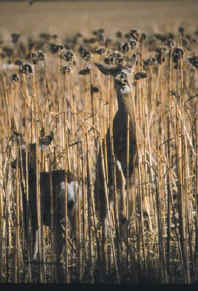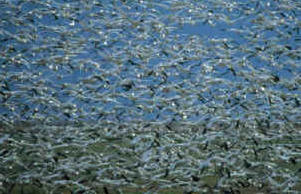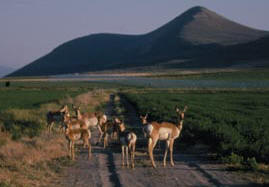|
Sharing the Land
Range
Magazine --
www.rangemagazine.com
Wildlife and agriculture
sharing the land can be spectacular and burdensome.
Story by Steve Kandra. Photos copyright Larry
Turner.
Fall issue 2004
The roar of the wings and the cackling calls
are deafening as the salt-and-pepper mix of snow and white-front
geese rise from the alfalfa field. Tens of thousands of birds fresh
from the rice fields of the Sacramento River Valley are foraging
their way north to Arctic nesting grounds.
The Kandra farm is
located next to the Tule Lake Wildlife Refuge in the Upper Klamath
Basin, on the border of Oregon and California. These are irrigated
lands of the now famous Klamath Project. We no longer measure the
seasons by positions of the sun; the seasons are now defined by
which species of wildlife is sharing the farmstead this day.
The spring waterfowl
migration is becoming more spectacular, and burdensome, every year.
Some wildlife guests are polite and share quite nicely; others sweep
in like locusts and consume everything green and growing, then leave
abruptly, but never soon enough. The Arctic nesters are the latter;
rude and persistent, they stay most of the month of April foraging
on my alfalfa fields. The resident Canada geese are the first to
nest and there are little “honkers” scampering back and forth from
canals to fields before the other geese head north. The cinnamon
teal and mallards are already pairing up and there will be little
ducks in the drain ditch by the end of May.
The mule deer herd
gets bigger every year. They migrate vertically, up on Sheepy Ridge
in the late winter and early spring, and down into the farm fields
in time to drop fawns the first of June. The fawns learn that farm
activity and swimming the canal will keep the cougars at a safe
distance.
The cattail rushes and
willows welcome blackbirds and thrushes. The fields are full of
larks and sparrows, for insects are the predominant species there.
Every power pole or irrigation pivot tower is a roost for a raptor
just waiting for the foolish rodent scampering from run to run. The
summer air is full of swifts and swallows, deftly plucking insects
out of the swarm of twilight. Red-tail hawks have built a nest in
the lofty poplar at the end of the lane, as they have done for all
the years that I can remember.
There are freshwater
mussel shells on the levee road left by a quartet of rampaging
otters that use the canals as convenient passages to mischief.
Herons, great blue and white, stalk the waterway edges for
amphibians that create a twilight peeping roar. The curlews and ibis
wade through irrigated pastures, tipping cow pies for hidden treats.
The canals and drains and the practical function of irrigation
provides a bounty of habitat and food.
For the gulls and
terns the sound of a diesel tractor engine starting is a dinner
gong. Swathing hay into windrows rudely exposes thousands of voles
to the gregarious gulls as they hover inches away from the
machinery. The gulls practice aerial theft of food from each other
and loudly gloat over every morsel. Songbirds sweep in to pick
through all the insects thrashed out onto the ground. Crows march
like monarchs through the other birds picking and choosing what
can’t escape.
The Kandra family has
been farming in the Klamath Basin since 1911. Through depression and
drought the family persists. Farming is not an occupation for the
timid. If you have any soul you will recognize that the soil begets
most of creation and all of civilization. It is sad and disturbing
that the urban dweller disconnects from the reality of fertile
earth. How soon we lose appreciation for those who steward the land,
becoming ignorant minds not encumbered by hungry stomachs.
Early summer and this
year’s crop of goslings already show their distinct cheek patches. A
redhead duck hen shepherds a successful clutch of 14 ducklings. A
great start, but I know that by the end of the summer predators will
pick off at least half of the brood. Teal and mallard ducklings fill
the drains and canals. In about 60 days they will be practicing
flight and, by October, ready to migrate.
The den of coyotes up
the hill must have a lot of mouths to feed this year. The parents
are active in the fields and watercourse edges even during the
daylight. The coyotes know that the night baling of hay will flush
out the voles, and follow close enough to the lighted machinery to
keep the springer spaniel, sharing the tractor seat, on edge. Out of
the darkness owls will flash into our lighted nighttime bubble as
they, too, take a trophy vole or two. A weasel peeks into my open
pickup door, taking measure of the dozing Labrador retriever. Ornery
enough to be successful in the battle, but unable to haul the trophy
home, the aggressive little predator moves on.
Labor Day usually
marks the beginning of the white-front geese return migration from
the north. The little herd of mule deer bucks have brushed off most
of the antler velvet, but the little spotted fawns still treat them
like cousins instead of future suitors or rivals. Family units of
ducks, sensing the need to move south, begin in earnest to forage
grain field edges. If the combine doesn’t arrive soon, there will be
little to harvest.
This 530-acre farm
will produce about three million pounds of premium alfalfa, 1.5
million pounds of potatoes, 2.7 million pounds of onions, 460,000
pounds of wheat, 300,000 pounds of barley, six to 10 mule deer
fawns, 100 honkers, about 200 ducks (five or six species), and
uncountable tons of voles for coyotes, eagles, and hawks. The
wildlife will consume or destroy about $25,000 of commodities.
As the fall harvest
begins, the migrating hoards glean through the fields. Along with
the grains and forage, the small potatoes are also consumed by geese
and deer. The days grow short and the weather rough. Most of the
birds that can migrate are gone, but there are always a few that are
spent before they can reach warmer climates. They become the victims
of predators and raptors. Nothing ever grows old, and nothing is
wasted. Piles of feathers dot the fields.
As freezeup occurs,
the swans congregate on the open waters, their trumpeting calls
filling the valley. A few remaining geese become trapped in the
quickly forming ice and become captive meals for eagles and coyotes.
The deer also figure out that the plastic snow fence barrier will
not keep them out of the hay barn when the winter snows fall. The
deer nose through the haystack and browse out the very best hay—a
new marketing standard—mule deer select! The voles happily tunnel
and multiply under the protective blanket of snow.
The seasons of life
will be renewed shortly. Just as they have for a hundred
generations, wildlife continues on the farm.
BIO
Steve Kandra is a rancher and farmer, Larry
Turner is a world-class photographer. They enjoy the birds and
wildlife and neighbor in south central Oregon.

As every gardener knows, deer head straight for
the good stuff.
These are feasting in a private sunflower
field near Tulelake,
California. Photo copyright Larry Turner

During spring and autumn migrations, millions
of snow geese forage on private
fields along the Oregon-California border.
Photo copyright Larry Turner

Where there are healthy ranches and farms,
there’s abundant wildlife.
Antelope breakfast in a farmer’s alfalfa field
in Klamath Basin, Oregon.
Photo copyright Larry Turner

Great egrets at play on a ranch near Merrill,
Oregon.
Photo copyright Larry Turner
|